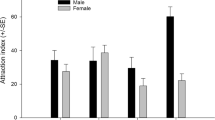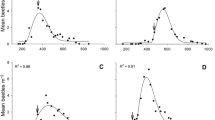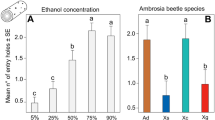Abstract
The redbay ambrosia beetle, Xyleborus glabratus, is an invasive wood-boring beetle that has become established in the southeastern United States. The beetle transmits the causal pathogen of lethal laurel wilt to susceptible host trees, which include redbay, an important forest community species, and avocado, a valuable food crop. By examining odors of redbay wood, we developed an artificial lure that captured X. glabratus in redbay forests. Eucalyptol was a critical component of the blend for beetle attraction, and eucalyptol alone in large quantities attracted X. glabratus. Furthermore, eucalyptol stimulated boring by X. glabratus into paper arenas. The results suggest that eucalyptol contributes to host selection behavior of X. glabratus and may be useful for management of this pathogen vector.





Similar content being viewed by others
References
Brar GS, Capinera JL, Kendra PE, McLean S, Peña JE (2013) Life cycle, development, and culture of Xyleborus glabratus (Coleoptera: Curculionidae: Scolytinae). Fla Entomol 96:1158–1167
Carrillo D, Duncan RE, Peña JE (2012) Ambrosia beetles (Coleoptera: Curculionidae: Scolytinae) that breed in avocado wood in Florida. Fla Entomol 95:573–579
Cox DR (1972) Regression models and life-tables. J R Stat Soc Ser B Methodol 34:187–220
Crawley MJ (2009) The R book. John Wiley & Sons, Chichester, UK
Elliott HJ, Madden JL, Bashford R (1983) The association of ethanol in the attack behaviour of the mountain pinhole borer Platypus subgranosus Schedl (Coleoptera: Curculionidae: Platypodinae). Aust J Entomol 22:299–302
Evans EA, Crane J, Hodges A, Osborne JL (2010) Potential economic impact of laurel wilt disease on the Florida avocado industry. Horttechnology 20:234–238
Formby JP, Schiefer TL, Riggins JJ (2012) First records of Xyleborus glabratus (Coleoptera: Curculionidae) in Alabama and in Harrison County, Mississippi. Fla Entomol 95:192–193
Fraedrich SW, Harrington TC, Rabaglia RJ (2007) Laurel wilt: a new and devastating disease of redbay caused by a fungal symbiont of the exotic redbay ambrosia beetle. Newsl Mich Entomol Soc 52:15–16
Fraedrich SW, Harrington TC, Rabaglia RJ, Ulyshen MD, Mayfield AE, Hanula JL, Eickwort JM, Miller DR (2008) A fungal symbiont of the redbay ambrosia beetle causes a lethal wilt in redbay and other Lauraceae in the southeastern United States. Plant Dis 92:215–224. doi:10.1094/pdis-92-2-0215
Fraedrich SW, Harrington TC, Bates CA, Johnson J, Reid LS, Best GS, Leininger TD, Hawkins TS (2011) Susceptibility to laurel wilt and disease incidence in two rare plant species, pondberry and pondspice. Plant Dis 95:1056–1062. doi:10.1094/Pdis-11-10-0841
Gershenzon J, Dudareva N (2007) The function of terpene natural products in the natural world. Nat Chem Biol 3:408–414
Hanula JL, Sullivan B (2008) Manuka oil and phoebe oil are attractive baits for Xyleborus glabratus (Coleoptera: Scolytinae), the vector of laurel wilt. Environ Entomol 37:1403–1409. doi:10.1603/0046-225x-37.6.1403
Hanula JL, Mayfield AE, Fraedrich SW, Rabaglia RJ (2008) Biology and host associations of redbay ambrosia beetle (Coleoptera: Curculionidae: Scolytinae), exotic vector of laurel wilt killing redbay trees in the southeastern United States. J Econ Entomol 101:1276–1286
Hanula JL, Sullivan BT, Wakarchuk D (2013) Variation in manuka oil lure efficacy for capturing Xyleborus glabratus (Coleoptera: Curculionidae: Scolytinae), and cubeb oil as an alternative attractant. Environ Entomol 42:333–340. doi:10.1603/en12337
Harrington T, Fraedrich S, Aghayeva D (2008) Raffaelea lauricola, a new ambrosia beetle symbiont and pathogen on the Lauraceae. Mycotaxon 104:399–404
Harrington TC, Yun HY, Lu SS, Goto H, Aghayeva DN, Fraedrich SW (2011) Isolations from the redbay ambrosia beetle, Xyleborus glabratus, confirm that the laurel wilt pathogen, Raffaelea lauricola, originated in Asia. Mycologia 103:1028–1036. doi:10.3852/10-417
Hulcr J, Lou Q-Z (2013) The redbay ambrosia beetle (Coleoptera: Curculionidae: Scolytinae) is a Lauraceae-specialist in its native range: records from the Chinese National Insect Collection. Fla Entomol 96:1595–1597
Hulcr J, Mogia M, Isua B, Novotny V (2007) Host specificity of ambrosia and bark beetles (Col., Curculionidae: Scolytinae and Platypodinae) in a New Guinea rainforest. Ecol Entomol 32:762–772
Hulcr J, Mann R, Stelinski LL (2011) The scent of a partner: ambrosia beetles are attracted to volatiles from their fungal symbionts. J Chem Ecol 37:1374–1377. doi:10.1007/s10886-011-0046-x
Kendra PE, Montgomery WS, Niogret J, Peña JE, Capinera JL, Brar G, Epsky ND, Heath RR (2011) Attraction of the redbay ambrosia beetle, Xyleborus glabratus, to avocado, lychee, and essential oil lures. J Chem Ecol 37:932–942. doi:10.1007/s10886-011-9998-0
Kendra PE, Niogret J, Montgomery WS, Sanchez JS, Deyrup MA, Pruett GE, Ploetz RC, Epsky ND, Heath RR (2012) Temporal analysis of sesquiterpene emissions from manuka and phoebe oil lures and efficacy for attraction of Xyleborus glabratus (Coleoptera: Curculionidae: Scolytinae). J Econ Entomol 105:659–669. doi:10.1603/Ec11398
irkendall L (1983) The evolution of mating systems in bark and ambrosia beetles (Coleoptera: Scolytidae and Platypodidae). Zool J Linn Soc 77:293–352
Kuhns EH, Tribuiani Y, Martini X, Meyer WL, Peña J, Hulcr J, Stelinski LL (2014) Volatiles from the symbiotic fungus Raffaelea lauricola are synergistic with manuka lures for increased capture of the redbay ambrosia beetle. Xyleborus glabratus Agric For Entomol 16:87–94
Mayfield AE, Hanula JL (2012) Effect of tree species and end seal on attractiveness and utility of cut bolts to the redbay ambrosia beetle and granulate ambrosia beetle (Coleoptera: Curculionidae: Scolytinae). J Econ Entomol 105:461–470. doi:10.1603/Ec11348
Mayfield AE, Peña JE, Crane JH, Smith JA, Branch CL, Ottoson ED, Hughes M (2008a) Ability of the redbay ambrosia beetle (Coleoptera: Curculionidae: Scolytinae) to bore into young avocado (Lauraceae) plants and transmit the laurel wilt pathogen (Raffaelea sp). Fla Entomol 91:485–487. doi:10.1653/0015-4040
Mayfield AE, Smith JA, Hughes M, Dreaden TJ (2008b) First report of laurel wilt disease caused by a Raffaelea sp. on avocado in Florida. Plant Dis 92:976–976. doi:10.1094/pdis-92-6-0976a
Mayfield AE, MacKenzie M, Cannon PG, Oak SW, Horn S, Hwang J, Kendra PE (2013) Suitability of California bay laurel and other species as hosts for the non-native redbay ambrosia beetle and granulate ambrosia beetle. Agr For Ent 15:227–235
Niogret J, Kendra PE, Epsky ND, Heath RR (2011) Comparative analysis of terpenoid emissions from Florida host trees of the redbay ambrosia beetle, Xyleborus glabratus (Coleoptera: Curculionidae: Scolytinae). Fla Entomol 94:1010–1017
Nishida R (2002) Sequestration of defensive substances from plants by Lepidoptera. Annu Rev Entomol 47:57–92
Osbourn AE (1999) Antimicrobial phytoprotectants and fungal pathogens: A commentary. Fungal Genet Biol 26:163–168
Pélissier Y, Marion C, Prunac S, Bessière J-M (1995) Volatile components of leaves, stems and bark of Cinnamonum camphora Nees et Ebermaier. J Essent Oil Res 7:313–315
Peña JE, Carrillo D, Duncan RE, Capinera JL, Brar G, Mclean S, Arpaia ML, Focht E, Smith JA, Hughes M, Kendra PE (2012) Susceptibility of Persea spp. and other Lauraceae to attack by redbay ambrosia beetle, Xyleborus glabratus (Coleoptera: Curculionidae: Scolytinae). Fla Entomol 95:783–787
Rabaglia RJ, Dole SA, Cognato AI (2006) Review of American Xyleborina (Coleoptera: Curculionidae: Scolytinae) Occurring North of Mexico, with an Illustrated Key. Ann Entomol Soc Am 99:1034–1056. doi:10.1603/0013-8746
Ranger CM, Reding ME, Persad AB, Herms DA (2010) Ability of stress related volatiles to attract and induce attacks by Xylosandrus germanus and other ambrosia beetles. Agric For Entomol 12:177–185
Walter AJ, Kells SA, Venette RC, Seybold SJ (2010) Boring in response to bark and phloem extracts from North American trees does not explain host acceptance behavior of Orthotomicus erosus (Coleoptera: Scolytidae). Environ Entomol 39:661–669
Zuur AF, Ieno EN, Walker NJ, Saveliev AA, Smith GM (2009) GLM and GAM for count data. In: Mixed effects models and extensions in ecology with R. Springer, pp 209-243
Acknowledgments
We thank two anonymous reviewers for their advice that improved a previous version of the manuscript. Jack Smoot and Russell Rouseff provided insights for and assisted with gas chromatography/mass spectrometry. We acknowledge Alice Bard for her help in securing appropriate permits from FDEP. Alpha Scents, Inc. graciously provided prototype lures for field trials. Funding for this research was provided by NIFA (USDA-SCRI) grant number 2009-51181-05915.
Author information
Authors and Affiliations
Corresponding author
Rights and permissions
About this article
Cite this article
Kuhns, E.H., Martini, X., Tribuiani, Y. et al. Eucalyptol is an Attractant of the Redbay Ambrosia Beetle, Xyleborus Glabratus . J Chem Ecol 40, 355–362 (2014). https://doi.org/10.1007/s10886-014-0427-z
Received:
Revised:
Accepted:
Published:
Issue Date:
DOI: https://doi.org/10.1007/s10886-014-0427-z




